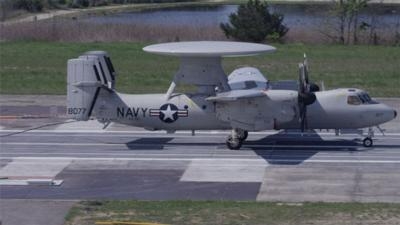Fri, Jun 29, 2018
Turbo-Electric System Designed For Controlled And Reliable Deceleration Of Aircraft
The Advanced Arresting Gear (AAG) system developed by General Atomics Electromagnetic Systems (GA-EMS) recently completed its first successful C2-A Greyhound aircraft arrestment at the Runway Arrested Landing Site (RALS) in Lakehurst, NJ. The next day, AAG successfully completed its first E-2D Advanced Hawkeye arrestment, with the E-2C+ Hawkeye following on June 8. GA-EMS, in collaboration with the U.S. Navy, is conducting AAG Performance Testing for the C-2A, E-2C+, and E-2D aircraft at RALS in preparation for the commencement of testing aboard USS Gerald R. Ford (CVN 78).

“This latest round of demonstration and testing is another major step toward bringing AAG to full air-wing readiness,” stated Scott Forney, president of GA-EMS. “Both AAG and EMALS continue to perform with great success. We are working closely with the Navy to thoroughly exercise these systems and test their range of capabilities to launch and recover the full spectrum of carrier-capable aircraft as the Navy advances CVN 78 toward its deployment target date.”
“Since the carrier’s July 2017 commissioning, the AAG system aboard CVN 78 has successfully arrested the F/A-18 Super Hornet 747 times,” stated Rolf Ziesing, vice president of Programs at GA-EMS. “We are now in the next phase of AAG capability and performance testing targeting heavier, prop-based C-2A, E-2C and E-2D aircraft. We’ll continue both roll-in and fly-in testing throughout the summer. Once RALS testing is completed, the aircraft will be cleared to begin testing aboard CVN 78.”
AAG is a turbo-electric system designed for controlled and reliable deceleration of aircraft. AAG is installed aboard CVN 78 along with the GA-EMS Electromagnetic Aircraft Launch System (EMALS), which uses electromagnetic technology to launch aircraft from the deck of naval aircraft carriers. Both systems have been successfully tested during at-sea periods on CVN 78, and are currently in production for the future John F. Kennedy (CVN 79) and Enterprise (CVN 80).
(Image provided with General Atomics Electromagnetic Systems news release)
More News
He Attempted To Restart The Engine Three Times. On The Third Restart Attempt, He Noticed That Flames Were Coming Out From The Right Wing Near The Fuel Cap Analysis: The pilot repor>[...]
Make Sure You NEVER Miss A New Story From Aero-News Network Do you ever feel like you never see posts from a certain person or page on Facebook or Instagram? Here’s how you c>[...]
From 2009 (YouTube Edition): Leading Air Show Performers Give Their Best Advice for Newcomers On December 6th through December 9th, the Paris Las Vegas Hotel hosted over 1,500 air >[...]
Aero Linx: NASA ASRS ASRS captures confidential reports, analyzes the resulting aviation safety data, and disseminates vital information to the aviation community. The ASRS is an i>[...]
“For our inaugural Pylon Racing Seminar in Roswell, we were thrilled to certify 60 pilots across our six closed-course pylon race classes. Not only did this year’s PRS >[...]
 NTSB Final Report: Rutan Long-EZ
NTSB Final Report: Rutan Long-EZ ANN FAQ: Turn On Post Notifications
ANN FAQ: Turn On Post Notifications Classic Aero-TV: ICAS Perspectives - Advice for New Air Show Performers
Classic Aero-TV: ICAS Perspectives - Advice for New Air Show Performers ANN's Daily Aero-Linx (06.28.25)
ANN's Daily Aero-Linx (06.28.25) Aero-News: Quote of the Day (06.28.25)
Aero-News: Quote of the Day (06.28.25)



